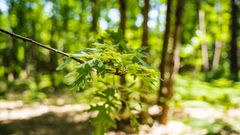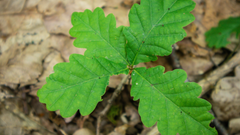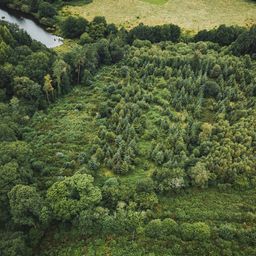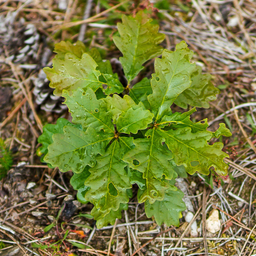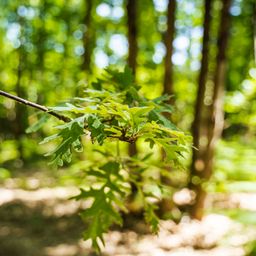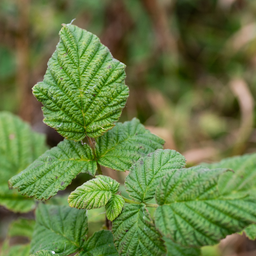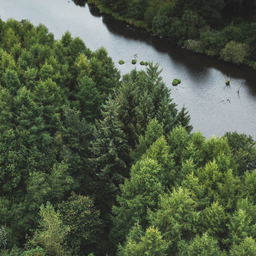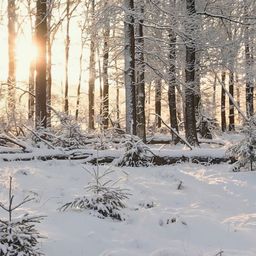Nov 19, 2025
Partial cuts: Why they are a necessary step in sustainable forest management
Discover how partial cuts, as part of EcoTree's sustainable forest management, enhance forest health and resilience.
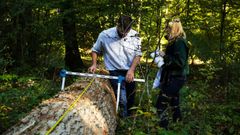
As a tree owner, your trees will at some point be cut. Some in 60 or 100 years, others in the near future. These cuts, whether planned or unplanned, are part of our commitment to sustainable forest management, which helps our forests thrive in the long term. Here, we’ll explain what partial cuts are, why we use them, and how they benefit both the forest and your investment.
At EcoTree, we are foresters; we plant and maintain forests in Europe. We practice a type of forest management known as mixed-species, continuous cover forestry, which involves planting, maintaining, and harvesting trees in our forests.
Key terminology:
Before we dive into how and why we cut trees in our forests, it's important to acknowledge that forest management comes with quite a complex terminology. So to start with, let’s go over the basics:
- Partial cut: Sometimes also known as 'selective cut', refers to harvesting a portion of the trees in a forest, typically to promote the growth of other trees and maintain the forest’s ecosystem. It can be planned or unplanned, depending on the circumstances.
- Clear-cutting: The process of removing all the trees in a given area, leaving the land bare. This method is typically used in non-sustainable forestry practices, specifically in monoculture forests, and contrasts with partial cuts, which maintain the forest structure.
- Monoculture forest: A type of forest where a single tree species is extensively grown, prioritising timber production efficiency but decreasing biodiversity. This lack of species variety makes them less ecologically healthy and resilient, increasing susceptibility to pests, diseases, and environmental shifts compared to mixed forests.
- Mixed-species forest: A forest which consists of a variety of tree species growing together, creating a more diverse ecosystem. At EcoTree, we plant between 3 and 15 different species in each forestry project, all of which support one another in various ways.
- Continuous cover forestry: A sustainable forest management practice where the forest is maintained with a constant canopy, and trees are selectively harvested to allow for natural regeneration without complete deforestation.
1. What are the benefits of partial cuts?
Partial cutting is a sustainable forest management practice that involves removing specific trees from a forest while leaving others to thrive. Unlike clear-cutting, which removes all the trees from an area, partial cutting helps maintain the forest’s health and biodiversity by allowing sunlight to reach younger trees and supporting a variety of species.
At EcoTree, we focus on continuous cover forestry, a method where the forest is never fully cleared, allowing the natural ecosystem and the forest canopy to remain intact. This approach helps the forest regenerate naturally, ensuring long-term sustainability. We do not perform clear-cuts in our forests; however, we do acquire forests that, in some cases, have been clear-cut by their previous owners, and change the management to our 'close to nature' approach, where we diversify the species and help restore the ecosystem in doing so.
2. Why do we choose to carry out partial cuts?
There are two main reasons why partial cuts might occur in our forests: planned cuts and unplanned cuts. Each serves a different purpose but contributes to the overall health and sustainability of the forest.
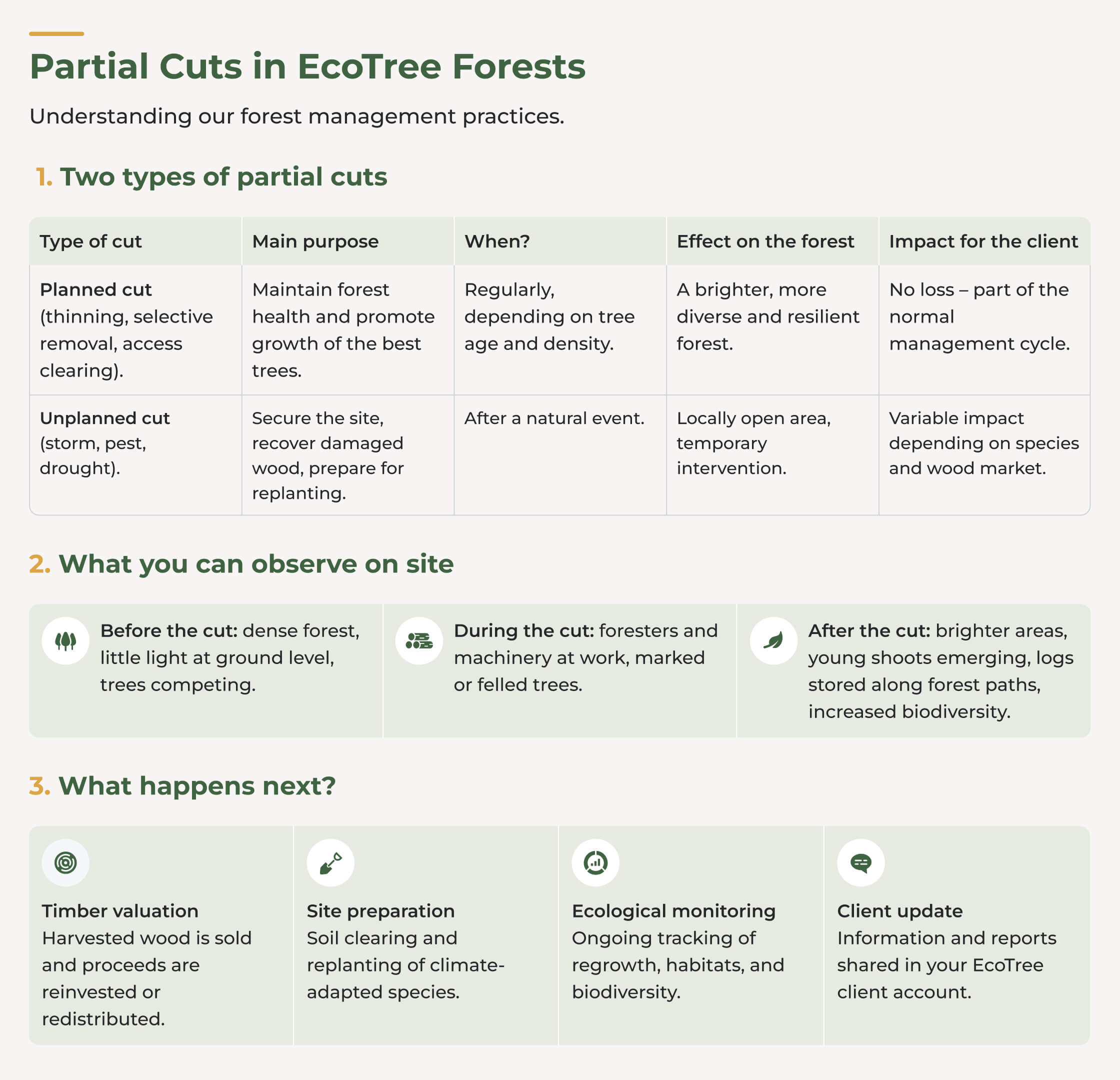
Planned cuts: enhancing forest health
Planned cuts are part of our long-term forest management strategy. As trees grow, it's essential to intervene to maintain the forest’s vitality and ensure that the strongest, most resilient trees have the space to grow. These interventions can include:
- Thinning cuts: This involves removing some trees to reduce competition, allowing others to access more light, water, and nutrients.
- Partitioning cuts: These create pathways for machinery and forestry workers, facilitating more efficient management.
- Reducing density: In some cases, less mature or lower-quality trees are removed to give more space for healthier trees to thrive.
By removing some trees, we make room for others to grow stronger, fostering a healthy and diverse ecosystem.
Unplanned cuts: responding to natural hazards
Sometimes, nature requires us to step in more urgently. Events such as storms, diseases, or droughts can damage the forest, making prompt intervention necessary. These unplanned cuts are essential for:
- Securing the forest: Removing fallen or damaged trees prevents further harm to the ecosystem.
- Recovering timber: We recover the timber before it deteriorates, helping the forest stay financially viable.
- Promoting regeneration: In cases where natural regeneration is not possible, we may support it by replanting trees or nurturing the existing vegetation.
For example, after the Ciaran Storm that hit France in 2023, we had to remove fallen trees and cut damaged trees in some of our forests, such as the Pleyben and Langoëlan forests in Brittany. While unexpected, these actions help maintain forest health and resilience in the face of nature’s challenges.
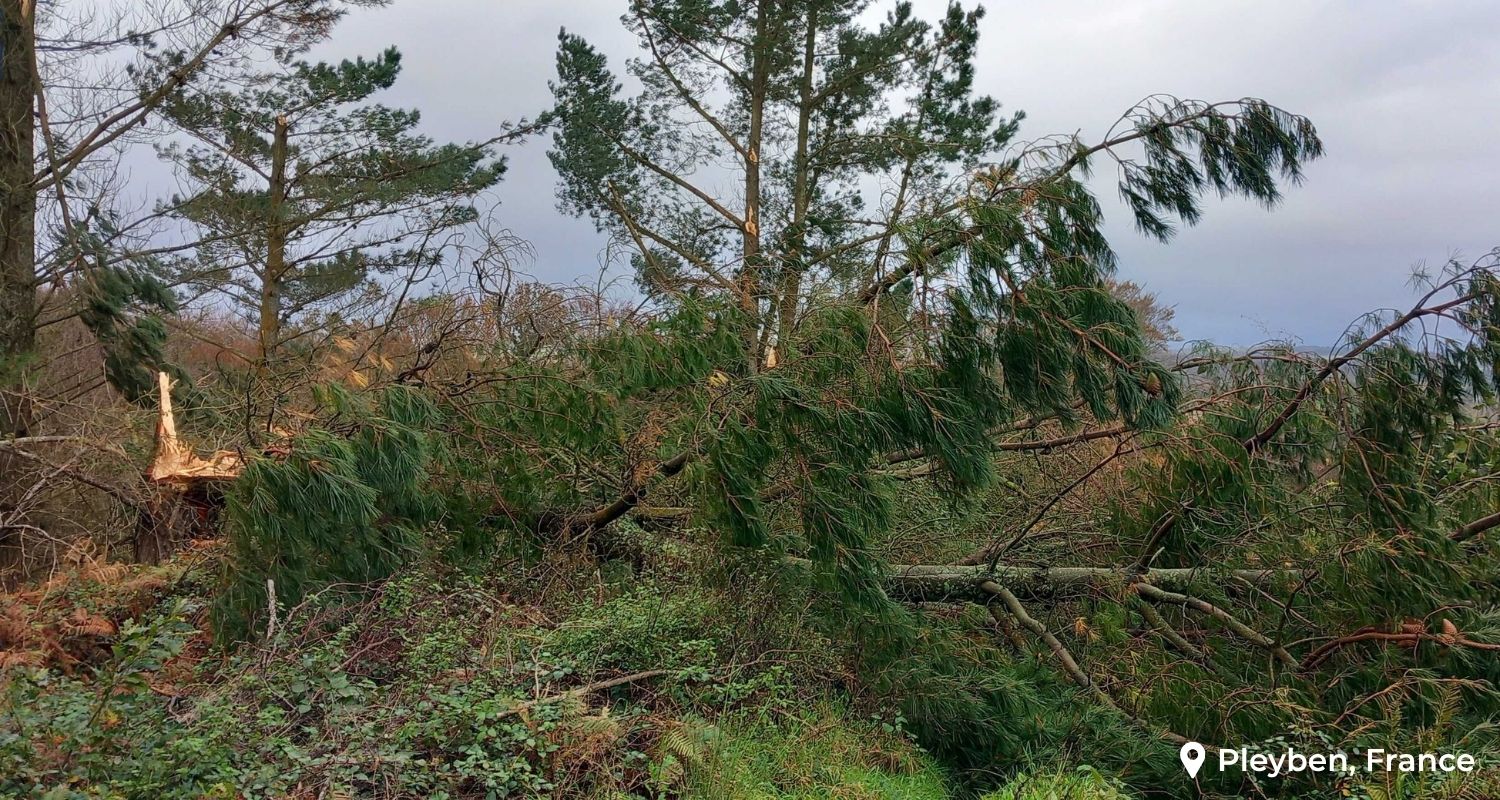
3. What impact do partial cuts have on tree yield for our customers?
In the case of planned cutting, there is no negative impact. These interventions are part of the normal cycle of forest management and have been planned and included in the management documents. In the long term, they even contribute to enhancing the quality of the wood and, consequently, its value. This is why some trees purchased by our customers have a shorter cutting horizon and lower yield than others, which have a much longer cutting horizon but with better expected profitability. You can find the planned cutting horizon for your trees in your EcoTree account.
In the case of unplanned cuts (after a storm, disease, etc.), the effects vary depending on the species, the age of the trees and the state of the timber market. In the Pleyben forest, for example:
- The conifers (Sitka spruce, Douglas fir) were able to be sold at a very satisfactory price, given the unforeseen circumstances.
- The hardwoods (Maple, Wild cherry, Red Oak) suffered a greater loss in value, as they fell before reaching the diameter required to be sold as timber (40 cm) and due to the current sluggish market for these rare species.
At EcoTree, we prioritise biodiversity by planting a diverse range of species, not just those with high revenue potential. This approach ensures the health and resilience of ecosystems, fostering long-term restoration and sustainability. While planting multiple species can come with additional costs, we see it as an essential investment in creating stronger, more resilient forests.
4. How can I track cuts in my EcoTree account?
We believe in transparency and communication with our customers. When planned or unplanned cuts are made, we ensure you are kept up to date through your EcoTree account.
For planned cuts
When planned cuts are made, you’ll receive an update in your EcoTree account detailing the amount you’re entitled to for the tree(s) harvested. We’ll notify you by email and through notifications on your account page.
For unplanned cuts
In cases where a cut is unplanned due to storms, disease, or other natural factors, we send a special communication to affected customers. For example, after the post-storm cuts in Pleyben and Langoëlan, we made sure all impacted customers were notified about the cuts and timber sales.
Once the trees are removed and sold, you’ll have the option to:
- Transfer the amount to your registered bank account, or
- Reinvest the proceeds into other EcoTree forestry projects.
Please note that these operations can take time, especially after an event like a storm, which may require extensive work. We will always go to great lengths to negotiate the best possible price for the timber and ensure that the harvesting process is carried out responsibly, following best practices for both the forest and local communities.
EcoTree’s long-term forest management
Partial cuts are not synonymous with loss, but rather with maintenance, regeneration and resilience. It reflects EcoTree's long-term commitment to preserving living forests and preparing ecosystems for the future.
At EcoTree, every cut is an act of sustainable management. It allows the forest to breathe, regenerate and prepare for the climate challenges ahead.

